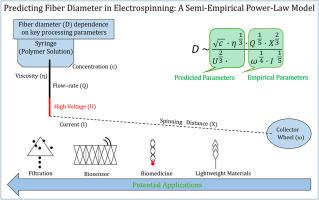Tunable diameter of electrospun fibers using empirical scaling laws of electrospinning parameters
IF 4.3
3区 材料科学
Q2 MATERIALS SCIENCE, MULTIDISCIPLINARY
引用次数: 0
Abstract
This study introduces a new semi-empirical power-law model for predicting electrospun fiber diameter (D), addressing key processing parameters. Polycaprolactone (PCL) fibers were produced using a solvent mixture of Trichloromethane (TCM), Dimethyl Formamide (DMF), and ethanol (EtOH). Systematic experiments validated an existing theoretical model and led to the development of a novel model: D ∼ (c1/2η1/3Q1/5X2/3)/(U2/3ω1/4I1/5). This model incorporates seven crucial parameters: viscosity (η), concentration (c), voltage (U), spinning distance (X), flow–rate (Q), current (I) and collector wheel rotation speed (ω). The model was validated through a partial factorial design experiment, proving to be a valuable and reliable tool for predicting fiber diameters and optimizing electrospinning processes. The ability to control fiber diameter is essential for tailoring electrospun fibers for various applications, including biomedicine, filtration, sensors, and lightweight materials.

利用电纺参数的经验缩放定律调节电纺纤维的直径
本研究针对关键加工参数,引入了一种新的半经验幂律模型来预测电纺纤维直径(D)。使用三氯甲烷 (TCM)、二甲基甲酰胺 (DMF) 和乙醇 (EtOH) 混合溶剂生产聚己内酯 (PCL) 纤维。系统实验验证了现有的理论模型,并由此建立了一个新模型:D ∼ (c1/2η1/3Q1/5X2/3)/(U2/3ω1/4I1/5) 。该模型包含七个关键参数:粘度 (η)、浓度 (c)、电压 (U)、旋转距离 (X)、流速 (Q)、电流 (I) 和收集轮转速 (ω)。该模型通过部分因子设计实验进行了验证,证明是预测纤维直径和优化电纺丝工艺的宝贵而可靠的工具。控制纤维直径的能力对于为生物医学、过滤、传感器和轻质材料等各种应用定制电纺纤维至关重要。
本文章由计算机程序翻译,如有差异,请以英文原文为准。
求助全文
约1分钟内获得全文
求助全文
来源期刊

Materials Chemistry and Physics
工程技术-材料科学:综合
CiteScore
8.70
自引率
4.30%
发文量
1515
审稿时长
69 days
期刊介绍:
Materials Chemistry and Physics is devoted to short communications, full-length research papers and feature articles on interrelationships among structure, properties, processing and performance of materials. The Editors welcome manuscripts on thin films, surface and interface science, materials degradation and reliability, metallurgy, semiconductors and optoelectronic materials, fine ceramics, magnetics, superconductors, specialty polymers, nano-materials and composite materials.
 求助内容:
求助内容: 应助结果提醒方式:
应助结果提醒方式:


